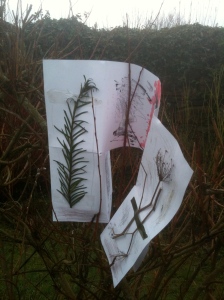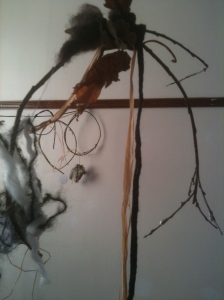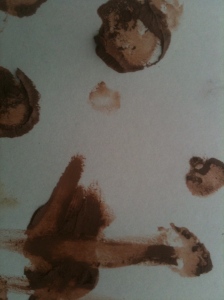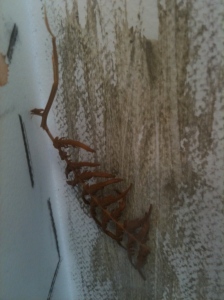Walking the Line, The Art of Richard Long
February 27, 2011
LANDMARKS: NATURE, ART, SCHOOLS
Week 3 – 9 Repeat Participants, 1 New Participant
Total Landmarks Participants – 79
Location: Ardee Library, County Louth
Feedback:
“Nature is art. Nature is so creative and colourful,” Ardee Educate Together National School, Teacher (5th Class).
“It was creative, colourful and fun,” Student (5th Class), Ardee Educate Together National School.
Land artists create artworks from natural materials, within a variety of atmospheric conditions, temperatures and terrains. Learning about the methods and ideas of these artists can fuel discussion, critical thinking, and generate new ideas for working with natural materials.
Richard Long (www.richardlong.org) is a walking artist, who uses his feet to create lines of drawing (or paths) across a variety of terrains throughout the world. He also creates cairns, stone circles and lines within the landscape and inside art galleries. These stone arrangements are also accompanied by ‘mudworks’, the mixing of clay and water to create large scale handprints and smearing across interior walls. Long uses photography to document the stones he assembles along his walks, and uses words to create a picture about his travels. He collects words, like he collects stones and clay, that are directly related to the landscape in which he walks. These ‘textworks’ are word pictures; they are direct encounters with the elements, his activity, and his senses. They are also precise statements about his experience. “Day to Day, Camp to Camp, Water to Water, Summit to Summit, Boulder to Boulder, Footpath to Footpath, Rainstorm to Rainstorm, Experience to Experience” (A Eight Day Walk in the Cairngorm Mountains, Scotland 2007 by Richard Long). 
Richard Long considers his art to be about a person walking down the road making his mark. In essence, Long makes his own map, his own route through territories both personal and elemental. He says, “I use the world as I find it” (Richard Long quoted in Land Art by Michael Lailach) His art offers a compelling influence for children and young people finding their sense of place. He encourages us to make our mark, and create landmarks as we make our way through the world.
This series of mud pictures, inspired by the artwork of Richard Long, were produced by 5th Class students at Ardee Educate Together National School. Two students wrote the following alongside their mud pictures:
“Nature is where my art is”
“Flower, Tree, Mountain”
Artist Books by Children
February 19, 2011


 LANDMARKS: NATURE, ART, SCHOOLS
LANDMARKS: NATURE, ART, SCHOOLS
Week 2 – 30 Participants
Total Landmarks Participants – 78
Location: Ardee Library, County Louth
Feedback:
“As the children created their books, the art pieces portrayed their innermost thoughts and feelings” Scoil Mhuire na Trocaire National School, Ardee, Teacher (4/5th Class)
By simply folding paper into accordion and three dimensional shapes, many different “pages” emerge for art and writing. A variety of different art materials can be used  to portray a child’s sense of nature – watercolour pastels, charcoal, oil pastels, ink stamps, photos, drawings, and samples of trees, grasses and flowers. The artist books were created by students visiting a number of different stations containing art materials. Through stamping, drawing, and collage the children worked in their own way, creating spontaneously to build up textures and assemble ideas. The small books were also an important expression of working within a library.
to portray a child’s sense of nature – watercolour pastels, charcoal, oil pastels, ink stamps, photos, drawings, and samples of trees, grasses and flowers. The artist books were created by students visiting a number of different stations containing art materials. Through stamping, drawing, and collage the children worked in their own way, creating spontaneously to build up textures and assemble ideas. The small books were also an important expression of working within a library.
Collectively the folded books create a kind of landscape of images, which can be displayed within a classroom either on a table or on a wall. The artist books can then be collectively re-positioned into many different kinds of overall shapes. By turning the books around, different pictures are revealed, so that a rotating display can be achieved within the classroom.
In The Irish Times, Michael Viney has recently written about the importance of children’s engagement with nature as fuel for their imagination (February 5, 2011). By observing and feeling nature, children generate a sense of wonder about the natural world. It is this sense of wonder that in turn encourages a receptivity to the changing states of seasons, weather, and growth. “Those who contemplate the beauty of the earth, find reserves of strength that will endure” (Rachel Carson, The Sense of Wonder). Artist books can map a child’s observations of nature, and document change. It is this contact with changing conditions that also reflects human nature. It is an opening to being in touch with a dynamic sensing of the world as ‘alive’. “It is not half so important to know as to feel” (Rachel Carson, The Sense of Wonder).
These are photos of folded books created by students of Scoil Mhuire na Trocaire and Ardee Educate Together National School.
Re-shaping Space – Assembling a Classroom Habitat
February 12, 2011
LANDMARKS: NATURE, ART, SCHOOLS
Week 1
Total Participants – 48
Location: Ardee Library, County Louth
Feedback:
“The workshop was very different and experimental, and offered creative freedom. The students were so interested they didn’t want to go,” Ardee Educate Together National School, Principal and Teacher (5/6 Class)
“That was really cool,” Student Ardee Educate Together National School (5/6th Class)
“A brilliant morning and they were all so keen” Ardee Brigin and Girl Guides
Transforming classroom space into a different kind of surrounding for students, is one of the goals of Landmarks: Nature, Art, Schools. Site-specific installation art is assembled for a particular space, and it is often composed from a collection of different ingredients. It is not unlike a three dimensional nature table, where organic materials are suspended, placed on the ground, and displayed on walls. It is an environment within reach of students, and may also become a den, shelter or breathing space within the school day. An installation encompasses an area, it can be entered into, and invites interaction. It offers a set of physical conditions which can affect the nature of the individual.
Incorporating ceiling hooks for suspending artworks can change the shape of a classroom. String, wool or wire can be hung from the hooks, so that students’ artworks can be attached over time. More dimensions are added to the overall classroom space, with layers of string/wool/wire becoming webs or geometrical patterns.
Assembling a collection of individual artworks into a larger entity, is an example of biodiversity. It is a habitat, whereby different kinds of artworks and people accommodate diversity. Different approaches, perspectives and ways of handling materials are brought together in one creative space. The fact that this habitat is mostly ‘natural’ means that it constantly changes, both growing and decaying at the same time.




